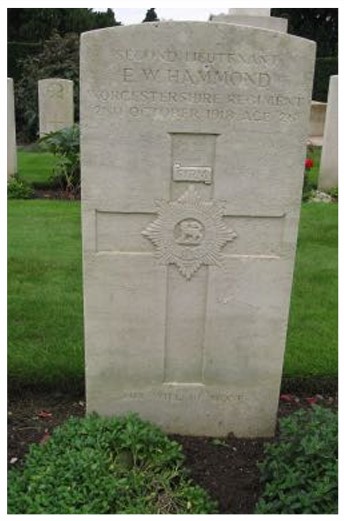1st Battalion, Worcestershire Regiment

Edward William Hammond was born at Gloucester in 1892. Originally a labourer, he enlisted into the Worcestershire Regiment (number 12153) on 15 June 1910, at Worcester.
Between October 1911 and January 1915, he was located in India, with the 2nd Worcesters and had risen to Corporal in December 1913.
The battalion returned to the UK on 5 January 1915 and on 21 March embarked from Avonmouth for the Dardanelles. Whilst there Edward, on 28 April, received a gunshot wound to his chest and was invalided to Malta. He was promoted to Serjeant on 7 May 1915.
On 8 June 1915 he had returned to England and was posted to the 6th Worcesters as a physical training instructor. On 2 July he married Mabel Beech and they had a daughter, Nina, just under a year later.
He returned to France on 23 December 1916, re-joining the 2nd Worcesters in the Zield on 6 March 1917. He had been recommended for a commission and returned to the UK for Officer training on 8 September 1917. A posting as a Second Lieutenant to the 1st Worcesters followed on 28 November 1917.
The 1st Worcesters were deployed in the Oppy Wood sector when, on 23/24 August 1918, they were subjected to a concentrated mustard gas attack. Second Lieutenant Hammond suffered burns to his arm, back and buttocks and was evacuated to the UK. On 10 September a medical board granted him a further three weeks’ sick leave and on 21 September he arrived at his mother’s house in Worcester, where he spent four days before returning to join his wife at 35 Marlborough Road, Gloucester. He was suffering from bouts of depression, which were seen as a reaction to his gas poisoning.
On 2 October 1918 he told his wife he was going out to post some letters. She heard a shot and discovered her husband dead in the bathroom, from a gunshot wound to the heart. A six chamber revolver was found at his side. An inquest jury returned a verdict of suicide ‘whilst temporarily insane’.
Second Lieutenant Edward William Hammond was buried in Gloucester Old cemetery, where a standard CWGC headstone now marks his grave.
Graham Adams
(from the Gloucestershire War Graves Project biographical archive)
